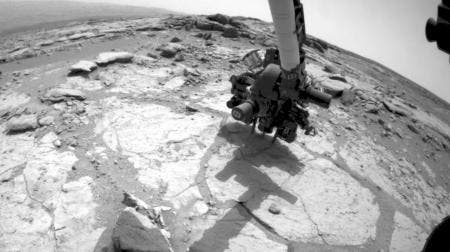Dating rocks is not really something new – it’s been conducted on Earth for decades now; researchers have also determined the age of rocks from outer space, but the experiments always took place on Earth. Now, for the first time, this procedure took place on Mars.

The work, led by geochemist Ken Farley of the California Institute of Technology (Caltech) could provide not only valuable information about the Martian geology, but give aid in the search for life on Mars.
With the huge importance of the Curiosity mission, every detail was planned in detail months before the shuttle was launched, but shortly before the rover left Earth in 2011, NASA’s participating scientist program asked researchers from all over the world to submit new ideas for experiments that could be performed with the already installed instruments. Farley was one of the 29 selected participants and he submitted a proposal to conduct a series of techniques fairly similar to those used on Earth do date rocks. His proposal was accepted, and in a paper published this week in the journal Science Express he and his colleagues conducted the first age determinations performed on another planet.
Before this geochronology experiment took place, scientists were using the so-called “crater counting” method, which had estimated the age of Gale Crater and its surroundings to be between 3.6 and 4.1 billion years old. Crater counting relies on a surprisingly simple fact: since Mars is constantly bombarded by meteorites, an area with more craters is going to be older; researchers have developed a way to transpose the number of craters into an estimated age.
With Farley’s method, the Curiosity rover calculated the age of the mudstone at Gale Crater to be about 3.86 to 4.56 billion years old – incredibly close to initial estimates!
“In one sense, this is an utterly unsurprising result—it’s the number that everybody expected,” Farley says.
Indeed, it seems absolutely shocking that such a simple method with so many uncertainties and estimations can be so accurate.
“What was surprising was that our result—from a technique that was implemented on Mars with little planning on Earth—got a number that is exactly what crater counting predicted,” Farley says. “MSL instruments weren’t designed for this purpose, and we weren’t sure if the experiment was going to work, but the fact that our number is consistent with previous estimates suggests that the technique works, and it works quite well.”
However, there is some uncertainty with this method as well. Since mudstone is a sedimentary rock, it is heavily subjected to erosion and other surface processes. The age of the sample drilled by Curiosity really is the age of the rock that was still left standing after these processes, and while the entire crater was almost certainly a lake at some point in its existence (and was capable of supporting life), it’s impossible with this method to know when this was happening.
Via CalTech.



